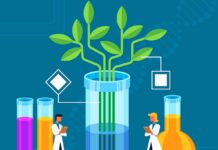Farming in India is a popular and still very mundane work that requires lots of hard work, planning, and patience. No matter how advanced a technology becomes or how developed a country becomes, there are still farmers who lack proper knowledge, and thus most of their agricultural practices are based on predictions, which mostly fail.
That’s why PsiBorg Technologies has developed a smart crop monitoring system using IoT to help farmers enhance their agricultural practices.
This smart, IoT-based crop monitoring system is easy to install and use.
This article will discuss everything you should know about a crop monitoring system and will give you an idea of why it’s beneficial for you.
Let’s get started by first defining a crop monitoring system.
IoT-based Smart Crop Monitoring System
A smart crop monitoring system uses IoT technology to collect data from various sensors and devices deployed in a crop field. This aforementioned system includes a smart IoT device and a mobile/web app. To facilitate precision farming techniques and maximize crop yields, the smart device is integrated with a variety of sensors and connectivity features.
If we have to explain it in simple terms, then,
Traditionally, farmers have to keep an eye on their crop fields or have workers who do this task, they will get to know about the disease in the crop only when it has already spread over the crops.
However, the smart crop monitoring system uses sensors that are deployed all over the crop fields. These sensors will sense and collect data related to soil health and crop health and send the data to the gateway.
All the data collected on the gateway is sent to the cloud, where it is aggregated, analyzed, and further displayed on mobile apps.
So if there’s a pest invasion chance in the crop field, you will get an alert. Also if the soil moisture level is low, you will get an alert to start the irrigation pump.
Types of Sensors Used in Smart Crop Monitoring System
A crop monitoring system using IoT provides real-time data on various agriculture-related factors that influence crop health and yield.
This system is embedded with a network of sensors deployed in the field, collecting data on crucial parameters like:
- Soil Moisture: Knowing the moisture content of the soil is essential for proper irrigation. Sensors detect dryness and trigger automated irrigation systems, preventing water waste and ensuring crops receive the amount of water they need.
- Temperature and Humidity: Temperature and humidity levels highly impact crop growth. Temperature and humidity sensors embedded in the device monitor these factors and alert farmers to potential problems like heat stress or excessive moisture, allowing them to take corrective actions.
- Nutrient Levels: Understanding the nutrient composition of the soil is vital for targeted fertilization. That’s why you need a soil health monitoring system. The soil sensors in agriculture analyze nutrient levels and provide insights into what changes are necessary for increased crop growth.
- Light Intensity: Light plays a critical role in photosynthesis, the process by which plants convert sunlight into energy. Light sensors embedded in the device measure light intensity and alert farmers to potential issues like insufficient sunlight due to excessive cloud cover.
- Pest and Disease Detection: Early detection of pests and diseases is very important for minimizing crop damage. Specialized sensors identify signs of infestation, allowing farmers to take timely intervention measures.
Data-Driven Decisions for Increased Crop Yields
IoT-based crop monitoring systems are beneficial because they can turn gathered data into insights that can be put to use. Advanced analytics platforms leverage machine learning and historical data to:
- Identify trends and patterns of crop growth. By analyzing agricultural field-related data over time, farmers can gain insights into the specific needs of their crops and adjust their practices accordingly.
- Predicting potential problems. IoT with ML algorithms analyzes past data and weather forecasts to predict potential issues like water shortages or pest outbreaks. This helps farmers take preventive measures and minimize crop losses.
- Improve resource usage and reduce resource wastage. The smart system gives insights and recommendations on irrigation schedules, fertilizer application, and other resource-intensive activities, leading to more efficient use of water, fertilizers, and energy.
- Better crop yield prediction. As mentioned previously, information gathered by IoT sensors on crop growth, weather patterns, and soil quality can be utilised to precisely forecast crop yields. This assists farmers in harvest planning and resource optimization.
- Remote monitoring and control. IoT-based crop monitoring devices, which can be remotely monitored and controlled, enable farmers to manage their crops from any location. This saves plenty of time and reduces labor costs.
Why Choose PsiBorg’s Crop Monitoring Solution Using IoT?
PsiBorg holds expertise in developing smart IoT solutions that help businesses attain great profits. It is one of the best IoT solution provider in Delhi, NCR.
Our smart crop monitoring system and soil health monitoring system do the same.
IoT is the best way to get data-driven insights in real-time.
PsiBorg’s smart crop monitoring system using IoT offers the following benefits:
- Real-time crop health monitoring
- Informed decision making
- Shareable reports
- Instant SMS alerts
- Customized solution for all types of businesses
IoT is a booming technology in the field of agriculture. If you want your agriculture business to skyrocket, then you should consider integrating smart IoT solutions like crop monitoring systems, soil health monitoring systems, and smart irrigation systems.








